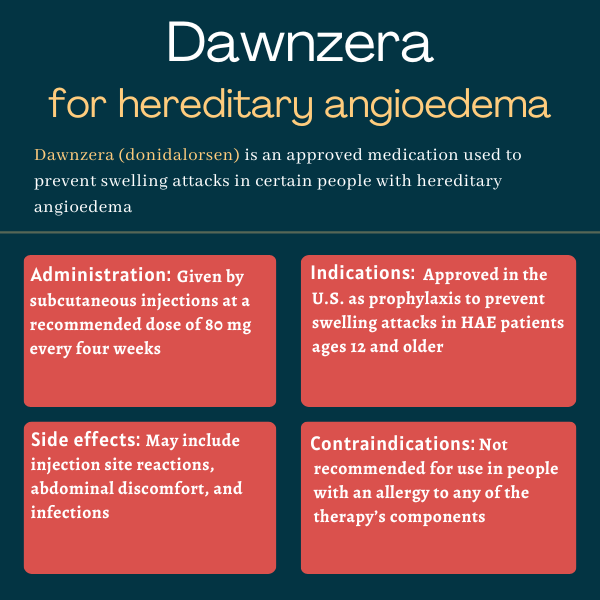Dawnzera (donidalorsen) for HAE
Last updated Aug. 26, 2025, by Marisa Wexler, MS

What is Dawnzera for hereditary angioedema?
Dawnzera (donidalorsen) is a prophylactic injection therapy approved in the U.S. to prevent swelling attacks in people ages 12 and older with hereditary angioedema (HAE).
Given via subcutaneous, or under-the-skin, injections that can be self-administered, Dawnzera is the first and only RNA-targeted therapy to be approved for HAE. It was developed by Ionis Pharmaceuticals, which holds the rights to the therapy in the U.S.
HAE is characterized by recurrent swelling attacks driven by the overproduction of a signaling molecule called bradykinin. Dawnzera is an RNA-targeted therapy that’s designed to reduce the production of prekallikrein, a precursor of kallikrein, which is an enzyme involved in the production of bradykinin. By doing so, Dawnzera is expected to prevent bradykinin levels from rising too high, and to reduce the risk of swelling attacks.
Therapy snapshot
| Brand name: | Dawnzera |
| Chemical name: | Donidalorsen |
| Usage: | Used to prevent swelling attacks in people with hereditary angioedema |
| Administration: | Subcutaneous injection |
Who can take Dawnzera?
Dawnzera is approved in the U.S. for use as a prophylactic treatment. It is designed to prevent swelling attacks in HAE patients ages 12 and older.
According to its prescribing information, Dawnzera should not be used by anyone with an allergy to any of the therapy’s components. Dawnzera also is not recommended for use in people with moderate or severe liver impairment.
How is Dawnzera administered?
Dawnzera is supplied in a single-dose autoinjector. It is given by subcutaneous injections that can be self-administered by patients or given by caregivers after proper training. The recommended dosage is 80 mg every four weeks. If this is well tolerated and effective, patients can talk to their care team about potentially switching to 80 mg given every eight weeks instead.
If self-administered, Dawnzera injections should be given into the thigh or abdomen. If someone else is administering the therapy, it may be injected into these sites or the upper arm.
Dawnzera should be stored in the refrigerator, but allowed to warm to room temperature for 30 minutes before administration.

Dawnzera in clinical trials
Dawnzera’s approval in the U.S. was based on data from a global Phase 3 clinical trial called OASIS-HAE (NCT05139810). The study enrolled 91 people, ages 12 and older, with HAE types 1 or 2, who were experiencing recurrent swelling episodes. Participants were randomly assigned to receive subcutaneous injections of Dawnzera or a placebo, given every month or every other month, for about six months.
Results from the OASIS-HAE study showed that Dawnzera:
- reduced monthly HAE attack rates compared with a placebo by 81% when given once monthly, and by 55% when given every other month
- lowered the rate of moderate or severe HAE attacks relative to a placebo by 89% when given once monthly and by 41% when given every other month
- reduced the rate of swelling attacks requiring on-demand treatment by 92% when administered once monthly and by 67% when given every other month
- increased the odds of being free from attacks by nearly 12 times when given every month
- led to improvements in life quality and fewer emergency room visits when compared with placebo
In the study, slightly more than half of Dawnzera-treated patients were free from swelling attacks from weeks four to 24, the data showed.
A Phase 3 open-label extension study called OASISplus (NCT05392114) is now evaluating the long-term safety and efficacy of Dawnzera in people with HAE types 1 or 2. The extension study enrolled patients who had completed OASIS-HAE, as well as individuals who had never received Dawnzera and had previously been on other prophylactic HAE therapies.
Available data from OASISplus thus far have indicated that patients on long-term Dawnzera saw a sustained reduction in swelling attack rates after up to a year of treatment. Further, individuals who switched to Dawnzera from other therapies tended to report fewer swelling attacks with Dawnzera.
Common side effects of Dawnzera
The most common side effects of Dawnzera include:
- injection site reactions
- upper respiratory tract infection
- urinary tract infection
- abdominal discomfort
Allergic reactions, including serious reactions known as anaphylaxis, have been reported following the use of Dawnzera. If patients show signs of an allergic reaction, treatment should be discontinued and appropriate supportive care should be administered.
Angioedema News is strictly a news and information website about the disease. It does not provide medical advice, diagnosis, or treatment. This content is not intended to be a substitute for professional medical advice, diagnosis, or treatment. Always seek the advice of your physician or other qualified health provider with any questions you may have regarding a medical condition. Never disregard professional medical advice or delay in seeking it because of something you have read on this website.
Recent Posts
- With chronic illness, we can’t brush off holiday stress so easily
- Abrupt danazol stop in HAE can cause temporary hepatitis: Study
- Being present and being there through chronic illness
- New HAE therapy delivers quicker relief in Phase 3 on-demand study
- ‘The Butterfly Effect’ warned me about unintended consequences
Related articles





